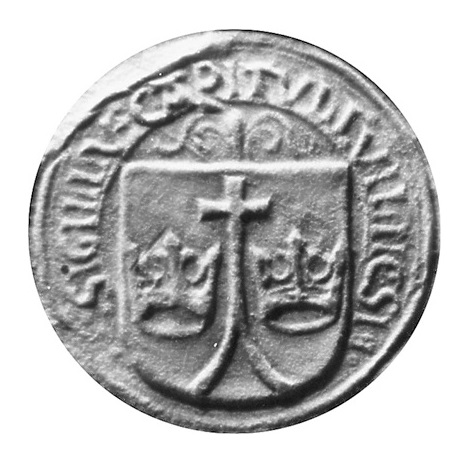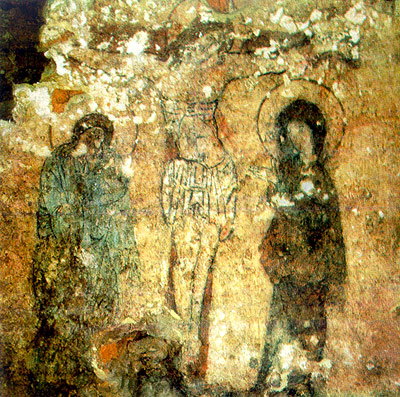|
Diocese Of Vilnius
The Roman Catholic Metropolitan Archdiocese of Vilnius ( la, Archidioecesis Vilnensis; lt, Vilniaus arkivyskupija) is an ecclesiastical territory or diocese of the Roman Catholic Church in Lithuania. Established as the Diocese of Vilnius in the 14th century, it was elevated to the rank of a metropolitan archdiocese by Pope Pius XI on October 28, 1925. It has two suffragan sees of Kaišiadorys and Panevėžys. The archdiocese's motherchurch and thus seat of its archbishop is Cathedral-Basilica of St. Stanislaus and St. Ladislaus in Vilnius; it also houses a minor basilica in Trakai. The current archbishop of Vilnius is Gintaras Grušas. He is assisted by auxiliary bishops Arūnas Poniškaitis and Darius Trijonis. History Establishment The Archdiocese owes its foundation to Jogaila, who Christened Lithuania in 1387 and sent Dobrogost, Bishop of Poznań as ambassador to the Pope Urban VI with a petition for the erection of an episcopal see at Vilnius and the appointmen ... [...More Info...] [...Related Items...] OR: [Wikipedia] [Google] [Baidu] |
Vilnius
Vilnius ( , ; see also other names) is the capital and largest city of Lithuania, with a population of 592,389 (according to the state register) or 625,107 (according to the municipality of Vilnius). The population of Vilnius's functional urban area, which stretches beyond the city limits, is estimated at 718,507 (as of 2020), while according to the Vilnius territorial health insurance fund, there were 753,875 permanent inhabitants as of November 2022 in Vilnius city and Vilnius district municipalities combined. Vilnius is situated in southeastern Lithuania and is the second-largest city in the Baltic states, but according to the Bank of Latvia is expected to become the largest before 2025. It is the seat of Lithuania's national government and the Vilnius District Municipality. Vilnius is known for the architecture in its Old Town, declared a UNESCO World Heritage Site in 1994. The city was noted for its multicultural population already in the time of the Polish–Lithuanian ... [...More Info...] [...Related Items...] OR: [Wikipedia] [Google] [Baidu] |
Pope Pius XI
Pope Pius XI ( it, Pio XI), born Ambrogio Damiano Achille Ratti (; 31 May 1857 – 10 February 1939), was head of the Catholic Church from 6 February 1922 to his death in February 1939. He was the first sovereign of Vatican City from its creation as an independent state on 11 February 1929. He assumed as his papal motto "Pax Christi in Regno Christi," translated "The Peace of Christ in the Kingdom of Christ." Pius XI issued numerous encyclicals, including '' Quadragesimo anno'' on the 40th anniversary of Pope Leo XIII's groundbreaking social encyclical '' Rerum novarum'', highlighting the capitalistic greed of international finance, the dangers of socialism/communism, and social justice issues, and ''Quas primas'', establishing the feast of Christ the King in response to anti-clericalism. The encyclical ''Studiorum ducem'', promulgated 29 June 1923, was written on the occasion of the 6th centenary of the canonization of Thomas Aquinas, whose thought is acclaimed a ... [...More Info...] [...Related Items...] OR: [Wikipedia] [Google] [Baidu] |
Poznań
Poznań () is a city on the River Warta in west-central Poland, within the Greater Poland region. The city is an important cultural and business centre, and one of Poland's most populous regions with many regional customs such as Saint John's Fair (''Jarmark Świętojański''), traditional Saint Martin's croissants and a local dialect. Among its most important heritage sites are the Renaissance Old Town, Town Hall and Gothic Cathedral. Poznań is the fifth-largest and one of the oldest cities in Poland. As of 2021, the city's population is 529,410, while the Poznań metropolitan area (''Metropolia Poznań'') comprising Poznań County and several other communities is inhabited by over 1.1 million people. It is one of four historical capitals of medieval Poland and the ancient capital of the Greater Poland region, currently the administrative capital of the province called Greater Poland Voivodeship. Poznań is a center of trade, sports, education, technology and touri ... [...More Info...] [...Related Items...] OR: [Wikipedia] [Google] [Baidu] |
Dobrogost
Dobrogost or Dobrohost is an old Slavic names, Slavic origin given name derived from the elements ''dobro'' ("kind, good") and ''gost'' ("guest, hospitality"). Notable people with the name include: *Jan Dobrogost Krasiński, Polish nobleman (szlachcic) *Ostroróg family, Dobrogost Ostroróg, castellan of Gniezno *a pseudonym of Polish writer Franciszek Ksawery Godebski See also *Slavic names External links * http://www.behindthename.com/name/dobrogost {{given name Slavic masculine given names Polish masculine given names ... [...More Info...] [...Related Items...] OR: [Wikipedia] [Google] [Baidu] |
Christianization Of Lithuania
The Christianization of Lithuania ( lt, Lietuvos krikštas) occurred in 1387, initiated by King of Poland and Grand Duke of Lithuania Władysław II Jagiełło and his cousin Vytautas the Great. It signified the official adoption of Christianity by Lithuania, the last pagan country in Europe. This event ended one of the most complicated and lengthiest processes of Christianization in European history. History Early contacts with Eastern Orthodox Christianity Lithuanians' contacts with the Christian religion predated the establishment of the Duchy of Lithuania in the 13th century. The first known record of the name Lithuania (''Litua''), recorded in the Annals of Quedlinburg in 1009, relates to Chalcedonian missionaries led by Bruno of Querfurt, who baptised several rulers of the Yotvingians, a nearby Baltic tribe. However, Lithuanians had more active contacts with the Kievan Rus' and subsequent Eastern Slavic states, which had adopted Eastern Orthodox Christianity follo ... [...More Info...] [...Related Items...] OR: [Wikipedia] [Google] [Baidu] |
CoA Vilnius Bishopric
Coa may refer to: Places * Coa, County Fermanagh, a rural community in County Fermanagh, Northern Ireland * Côa River, a tributary of the Douro, Portugal ** Battle of Coa, part of the Peninsular War period of the Napoleonic Wars ** Côa Valley Paleolithic Art, one of the biggest open air Paleolithic art sites * Quwê (or Coa), an Assyrian vassal state or province from the 9th century BC to around 627 BCE in the lowlands of eastern Cilicia ** Adana, the ancient capital of Quwê, also called Quwê or Coa * Côa (Mozambique), central Mozambique People * Eibar Coa (born 1971) Other uses * Coa de jima, or coa, a specialized tool for harvesting agave cactus * Continental Airlines, major US airline * c.o.a., coat of arms * Coa (argot) ( es), criminal slang used in Chile See also * COA (other) * ''Coea'', a genus of butterflies * ''Coua Couas are large, mostly terrestrial birds of the cuckoo family, endemic to the island of Madagascar. Couas are reminiscent of African ... [...More Info...] [...Related Items...] OR: [Wikipedia] [Google] [Baidu] |
Renaissance Coat Of Arms Of The Cathedral Chapter Of The Roman Catholic Diocese Of Vilnius
The Renaissance ( , ) , from , with the same meanings. is a period in European history marking the transition from the Middle Ages to modernity and covering the 15th and 16th centuries, characterized by an effort to revive and surpass ideas and achievements of classical antiquity. It occurred after the Crisis of the Late Middle Ages and was associated with great social change. In addition to the standard periodization, proponents of a "long Renaissance" may put its beginning in the 14th century and its end in the 17th century. The traditional view focuses more on the early modern aspects of the Renaissance and argues that it was a break from the past, but many historians today focus more on its medieval aspects and argue that it was an extension of the Middle Ages. However, the beginnings of the period – the early Renaissance of the 15th century and the Italian Proto-Renaissance from around 1250 or 1300 – overlap considerably with the Late Middle Ages, conventionally da ... [...More Info...] [...Related Items...] OR: [Wikipedia] [Google] [Baidu] |
Arūnas Poniškaitis
Arūnas is a masculine Lithuanian given name and may refer to: * Arūnas Bižokas (born 1978), ballroom dancer *Arūnas Bubnys (born 1961), historian and archivist * Arūnas Degutis (born 1958), politician * Arūnas Dulkys (born 1972), economist and Minister of Health * Arūnas Eigirdas (born 1953), politician * Arūnas Gelažninkas (born 1985), motocross, enduro and rally raid rider * Arūnas Jurkšas (born 1972), track and field athlete * Arūnas Klimavičius (born 1982), footballer * Arūnas Matelis (born 1961), documentary film director * Arūnas Mika (born 1970), footballer * Arūnas Mikalauskas (born 1997), basketball player * Arūnas Pukelevičius (born 1973), footballer * Arūnas Savickas (born 1975), retired freestyle swimmer *Arūnas Valinskas (born 1966), showman, TV producer and host, and politician * Arunas Vasys (born 1943), American football player *Arūnas Visockas Arūnas Visockas (born 7 December 1965) is a retired Lithuanian basketball player for the Lithuan ... [...More Info...] [...Related Items...] OR: [Wikipedia] [Google] [Baidu] |
Church Of The Visitation Of The Blessed Virgin Mary, Trakai
St. Mary Church in Trakai, Lithuania, is a Roman Catholic church. It was founded by Vytautas the Great in 1409 and constructed in gothic style. Later it was significantly altered during the Baroque period, and its current appearance is mostly defined by these alterations. The main altarpiece contains the icon, The Mother of God of Trakai The Mother of God of Trakai (russian: Мадонна Тракайская) is a Roman Catholic icon, located in the main altarpiece of the St. Mary Church in Trakai, Lithuania. Pope Clement XI sent Bishop Konstanty Kazimierz Brzostowski for .... Sources * Tomasz Krzywick. Litwa: przewodnik, Oficyna Wydawnicza "Rewasz", 2005, p. 402 (in Polish). {{Coord, 54, 38, 34.3, N, 24, 56, 4, E, display=title Buildings and structures in Trakai Roman Catholic churches in Lithuania Tourist attractions in Vilnius County ... [...More Info...] [...Related Items...] OR: [Wikipedia] [Google] [Baidu] |
Basilica
In Ancient Roman architecture, a basilica is a large public building with multiple functions, typically built alongside the town's forum. The basilica was in the Latin West equivalent to a stoa in the Greek East. The building gave its name to the architectural form of the basilica. Originally, a basilica was an ancient Roman public building, where courts were held, as well as serving other official and public functions. Basilicas are typically rectangular buildings with a central nave flanked by two or more longitudinal aisles, with the roof at two levels, being higher in the centre over the nave to admit a clerestory and lower over the side-aisles. An apse at one end, or less frequently at both ends or on the side, usually contained the raised tribunal occupied by the Roman magistrates. The basilica was centrally located in every Roman town, usually adjacent to the forum and often opposite a temple in imperial-era forums. Basilicas were also built in private residences an ... [...More Info...] [...Related Items...] OR: [Wikipedia] [Google] [Baidu] |
Mother Church
Mother church or matrice is a term depicting the Christian Church as a mother in her functions of nourishing and protecting the believer. It may also refer to the primary church of a Christian denomination or diocese, i.e. a cathedral or a metropolitan church. For a particular individual, one's mother church is the church in which one received the sacrament of baptism. The term has specific meanings within different Christian traditions. Catholics refer to the Catholic Church as "Holy Mother Church". Church as an organization Primatial local churches The "first see", or primatial see, of a regional or national church is sometimes referred to as the mother church of that nation. For example, the local Church of Armagh is the primatial see of Ireland, because it was the first established local church in that country. Similarly, Rome is the primatial see of Italy, and Baltimore of the United States, and so on. The first local church in all of Christianity is that of Jerusalem ... [...More Info...] [...Related Items...] OR: [Wikipedia] [Google] [Baidu] |





